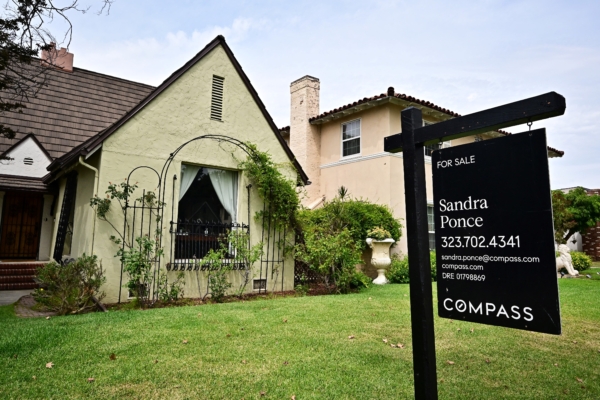On Wednesday, September 17th, after a 9-month hiatus, the Federal Reserve (Fed) finally announced a rate cut, expected to trigger a large-scale refinancing frenzy. However, in the current economic environment, the entire housing market is still full of volatility. So, as we enter 2026, what changes can we expect in the sizzling California real estate market?
The Epoch Times reporter recently interviewed Oscar Wei, Deputy Chief Economist of the California Association of Realtors (C.A.R.), on issues such as housing price changes, inventory levels, the best time to buy and sell homes, and popular housing market areas in California for 2026. Wei provided some of the latest forecasts and professional insights.
According to the latest report released by C.A.R. on Wednesday, sales of California homes in 2026 are expected to see a slight uptick, with median prices projected to rise by 3.6% to reach $905,000.
Wei stated, “We expect that housing prices will not rise significantly in 2026, which is good news for buyers. However, they are still expected to grow modestly by 3.6%.” He added, “Meanwhile, the housing supply remains tight, but the market may see a slight improvement next year with a projected increase of about 10% in listed properties.”
He pointed out that with housing prices and supplies synchronously growing slightly, and with interest rates beginning to ease, the California housing market in 2026 is poised for a rebound.
On Wednesday, the Federal Reserve announced a 25 basis point reduction in the federal funds rate, marking the first rate cut in the past 9 months. The dot plot suggests that there could be two more rate cuts within 2025, bringing a glimmer of hope to many who are following the real estate market.
Freddie Mac data shows that in the week ending September 11th, the average fixed mortgage rate for a 30-year mortgage was 6.35%, and for a 15-year mortgage was 5.5%.
Wei believes that 2026 is a good time for buyers. This is mainly due to two reasons: first, the 30-year fixed-rate mortgage may further drop to 6% in 2026, and secondly, the increase in housing supply will provide buyers with more options. The combination of the two factors will mitigate the impact of modest price increases, making the market still attractive to buyers.
He also suggested that buyers should not expect rates to drop significantly to 5%, 4%, or even lower, as “this expectation is unlikely to materialize”. Furthermore, for those with an urgent need to buy a house, they should consider not only interest rates but also the simultaneous increase in housing prices.
For sellers, Wei pointed out that many sellers have refrained from selling due to their reluctance to give up low interest rate loans (e.g., below 3%) obtained during the pandemic, creating a “mortgage lock effect”. With the decline in interest rates, sellers looking to relocate or upgrade should consider seizing the opportunity in the coming months.
“A slight increase in overall housing prices will help ease the burden of relocation, and one should take advantage of low interest rates when upgrading,” he said.
In recent years, due to continuous changes in the housing market coupled with economic market instability, many have been worried about the risk of a housing market collapse.
From an economic professional perspective, Wei believes that the California housing market in 2026 remains stable with minimal chances of a collapse, rather steady growth is anticipated. Unless unforeseeable major economic events occur, such as the financial crises or global pandemics seen previously, “these fall under unpredictable factors”.
“When people talk about whether the housing market will collapse, it usually implies that housing prices may see a significant drop. If prices indeed start to plummet by 10%, 15%, or 20%, it could be a sign of a bursting bubble occurring in the market,” he pointed out. “But as mentioned earlier, the average house price in the state is expected to actually rise by 4% next year. So, we believe that prices will not see a significant decline.”
California’s housing market is always in demand, with prices rising in many areas year after year. So which areas will be more sought after in the market in 2026?
According to Wei’s professional analysis, the most competitive markets in 2026 are likely to be in the suburbs surrounding the San Francisco Bay Area, such as Sacramento, Solano, and Sonoma. In Southern California, areas like Inland Empire, which are just over an hour’s drive from Los Angeles, may be more attractive.
He further analyzed that metropolitan areas like San Francisco and San Jose in the Bay Area will retain their housing market status, but due to the high prices and changes in people’s work patterns, many are opting to move to nearby cities. “The more affordable housing market in areas like Inland Empire also fits this scenario.”
According to C.A.R.’s data from last month, the median house price in San Francisco in July exceeded $1.6 million, while the most expensive, San Mateo, had an average price of $2.1 million, whereas Sacramento had a median price of only $559,000.
In Southern California, the median house price in Los Angeles County in July was $845,000, while in Inland Empire, the average price was $589,000.
Experts at C.A.R. believe that the California housing market will continue to face a range of challenges in the coming year, including the ongoing trade wars, the housing insurance crisis, and potential stock market bubbles.

